
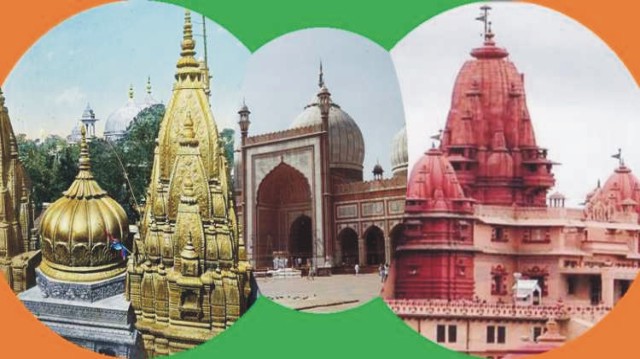
With a case filed by five women regarding worship at the Gyanvapi mosque in Varanasi, a flood of issues related to India’s troubled past is being witnessed.
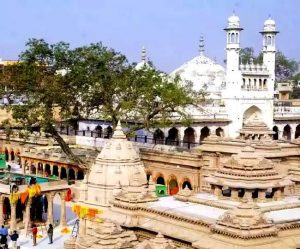 The Gyanvapi controversy, where the mosque was said to have been built by demolishing an ancient Vishwanath temple, has been supplemented by a similar Hindu-Muslim row at Krishna Janmbhumi in Mathura. That’s not all.
The Gyanvapi controversy, where the mosque was said to have been built by demolishing an ancient Vishwanath temple, has been supplemented by a similar Hindu-Muslim row at Krishna Janmbhumi in Mathura. That’s not all.
Claims are floating about the Taj Mahal, Qutub Minar, Jama Masjid in Delhi and every conceivable major relic built by Muslim kings. The argument is being proffered that Islamist claims over Hindu sites like Ayodhya earlier need to be quashed and these places be restored to Hindus to whom they belong after having been wrongfully appropriated/destroyed/modified by medieval Muslim rulers.
Arguments are also floating that a future cannot be built by ignoring the past. That secularism is not suitable for a country like India as the country needs truth and justice.
It is claimed that the past cannot be regarded as dead and the cutoff date of 1947 has been imposed without a proper debate through the Places of Religious Act in 1991, passed by Parliament, without any consultation with the victim community (read Hindus).
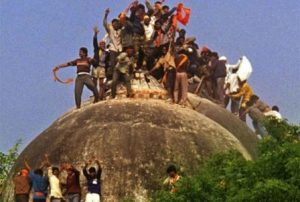 The arguments being repeated ad nauseam seem to be preparing the ground for massive repetition of what happened in 6th December 1992, the demolition of Babri mosque.
The arguments being repeated ad nauseam seem to be preparing the ground for massive repetition of what happened in 6th December 1992, the demolition of Babri mosque.
Most of these arguments totally negate the principles of India’s freedom struggle, the Indian Constitution and a rational understanding of the past. The Places of Religious Worship Act is being criticized as demonic.
India has a long history but it is during the last few decades that the demolition ideology seems to be leading the ideologues of right-wing. Medieval history during which many Muslim kings ruled is the central part of criticism; it is being projected as the period of atrocities on Hindus.
Conquering minds
The Hindu versus Muslim binary is being propagated and, in a way, imposed on social thinking by India’s most dominant political organization and its myriad associates.
By repeatedly propagating this they seem to have succeeded in creating a ‘social common sense’ of temple destructions, forcible conversion, and an Islamist supremacist project of Muslim kings. The real binary of Indian society is buried in this false narrative.
The rule of Muslim kings in no way was driven by the goal of spreading Islam or establishing the supremacy of Islam. The kings, Muslims or Hindus, were ruling in collaboration with the powerful landlords and kings, irrespective of their religion.
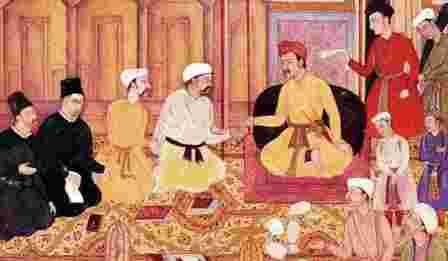
Be it Muslim kings, Akbar to Aurangzeb, they were associated with the landlords/kings of other religions. Kingdoms were based on a feudal system and not around religion.
Emperor Akbar had Birbal, Todarmal, Man Singh and a horde of others doing his bidding; he was also getting advice from them. Aurangzeb had nearly a third of court officials who were Hindus as per historian M Athar Ali’s book.
The wars were not along religious lines. Hindu king Shivaji’s initial battles were against Hindu king Chadra Rao More; Sikh gurus had serious confrontation with Hindu kings who were ruling in neighboring hills. The places of worship might have been destroyed for a myriad reasons of wealth, political rivalries and rebels against kings hiding in those places.
Syncretic culture
Indian culture has been a mix of cultures of people of diverse religions, Hindus and Muslims in the main. Even Islam did not spread through kings, though some Muslim kings did put the condition of conversion to Islam on the rival king. The mass conversions have been mainly due to the longing of those oppressed by the Hindu caste system.
To project Hindus as being oppressed by Muslims is off the mark. The economic oppression of Hindu and Muslim poor was at the hands of the landlords for revenue collection. The other oppression was that of the caste system which has been the hallmark of Indian society.
That’s how Dr. B.R. Ambedkar, considered the framer of the Indian Constitution, sees Indian history. He says the coming of Buddhism was a revolution as it challenged the caste system. The following period was the period of counter-revolution in which there was a massive attack on Buddhists and places of Buddhist worship.
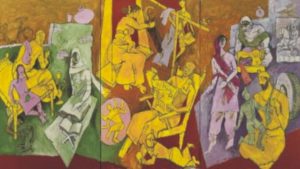
In a way, this is the real binary of Indian society. The hegemonic upper caste ideology was pitted against the low caste untouchables (later called Dalits).
The motives behind the killings of Buddhists were ideological. Pushyamitra Shung went to the extent of offering a golden coin to anyone who brings the head of a Buddhist monk. This is what wiped out Buddhism from the land of its birth.
Freedom struggle
During the freedom movement it was correctly perceived by the national movement that the British, the colonizers, have oppressed us the Indians. So it directed its energies against British rule. During this period the upholders of upper caste/elite ideology focused on the ‘foreigner’ Muslims, and kept aloof from the movement and struggle to throw out British rule.
They went on to construct the narrative of tyrannical Muslim rule and the need to have a “Hindu nation”. That’s why the very notion of secularism is alien to them and they oppose it as a Western concept. Their rooting is in the social system of kingdoms, where kings-landlords ruled and exploited the poor in the name of religion.
The modern state, modernity, has no place for such this landlord-clergy alliance lording over the people. Secularism is a universal value where the state is above religion and looks at the citizen as equal irrespective of one’s religion.
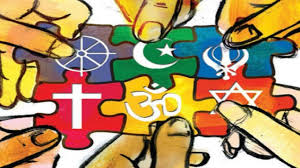 The defenders of demolition projects and diggers of the past are not only opposed to pluralism and secular values but also are totally blind to the demolitions of places of worship of Buddhists or Jains for that matter. They selectively pick up a few cases and harp on that. This is made to reflect on today’s Muslims and this divisive ideology lays the foundation of hate, violence and polarization.
The defenders of demolition projects and diggers of the past are not only opposed to pluralism and secular values but also are totally blind to the demolitions of places of worship of Buddhists or Jains for that matter. They selectively pick up a few cases and harp on that. This is made to reflect on today’s Muslims and this divisive ideology lays the foundation of hate, violence and polarization.
The increased clout of this ideology is seen in trying to compare the Places of Religious Worship Act with farmer laws that needed to be repealed.
The 1991 act was aimed at focussing social energies on building the future while preserving the integrative aspects of Indian syncretism, what Jawaharlal Nehru underlined as “Ganga-Jamuna tehjeeb” (syncretic fusion of Hindu and Muslim religo-cultural elements).
Also Read: Gyanvapi Mosque: Digging up the past to ruin the future
This is well reflected in what Goswami Tulsidas, the celebrated author of Ram Charitmanas, says in his Kavitavali:
“Tulsi Sarnaam Gulam hai Ramko, Jako Ruche so kae Vohu,
Maang ke Khaiboo, Masit ma soibo, Lebe ko Ek no debe ko Do.”
(My name is Tulsi, I am a slave of Ram. My give and take with the World is done. I live on alms and sleep in a mosque.) ![]()
__________________
Also Read:
Centre’s Opaque Auction Rules For Pulses Rip Off Govt Coffers, Help Millers Strike Rich
Need to amend laws like UAPA to provide for punishment for those who slap false cases
Global Arms Trade: Who are the real winners?
Why not 40 pc tickets for women in Punjab and elsewhere?
Punjab – How a deadly cocktail of Agri-Water-Energy nexus going to destroy it?
North Pole and the ideological conflict of RSS & Hindutva
Politics of Symbolism: Dalit Chief Ministers in India

Disclaimer : PunjabTodayTV.com and other platforms of the Punjab Today group strive to include views and opinions from across the entire spectrum, but by no means do we agree with everything we publish. Our efforts and editorial choices consistently underscore our authors’ right to the freedom of speech. However, it should be clear to all readers that individual authors are responsible for the information, ideas or opinions in their articles, and very often, these do not reflect the views of PunjabTodayTV.com or other platforms of the group. Punjab Today does not assume any responsibility or liability for the views of authors whose work appears here.
Punjab Today believes in serious, engaging, narrative journalism at a time when mainstream media houses seem to have given up on long-form writing and news television has blurred or altogether erased the lines between news and slapstick entertainment. We at Punjab Today believe that readers such as yourself appreciate cerebral journalism, and would like you to hold us against the best international industry standards. Brickbats are welcome even more than bouquets, though an occasional pat on the back is always encouraging. Good journalism can be a lifeline in these uncertain times worldwide. You can support us in myriad ways. To begin with, by spreading word about us and forwarding this reportage. Stay engaged.
— Team PT


Copyright © Punjab Today TV : All right Reserve 2016 - 2024 |